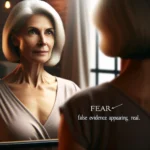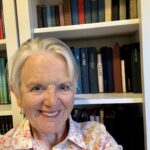Positive outcomes flow when rural women unite in art to battle hard times

Positive outcomes flow when rural women unite in art to battle hard times
By Mary Salce AO
Some things in life you want to forget and some you want to share in order to make a better place for women and families, and at the same time connect people in their communities.
 Some people in rural communities are often happy to do their own thing, others are unable to connect and need support in belonging to their local community.
Some people in rural communities are often happy to do their own thing, others are unable to connect and need support in belonging to their local community.
This story begins in the 1970s, when Australia left the European Common Market and dairying suffered a large fall in commodity prices. At this time, dairy farmers had difficulty in gaining support, or even recognition of the threat to family farms.
Getting food on the table for the family became a real concern. Young people could not see a future for themselves on the land and left for jobs in the city. Land values fell. Local communities felt their way of life was being threatened, and so it was.
In the 1970s and 1980s, Gippsland women lobbied all levels of Australian Government for household financial support. They did not simply want to repeat what men were saying but wanted answers to the questions.
Women wanted spreadable butter to be introduced on supermarket shelves, a decrease in the size of flavoured milk cartons for school lunches and lower prices for smaller packs of cheese and more variety. They wanted food to put on their table, they wanted to clothe their children, and they wanted the means to meet the costs of so-called “free” education.
Women also wanted answers to wider questions which included:
- will our children be able to be farmers?
- will our rural towns survive?
- what is the social cost of any scheme?
and
- how can we ensure a sustainable future for agriculture?
There was no positive image and no planned target for the future. When women did speak out, they were ridiculed by representatives of some Australian farming organisations.
The early 1980s also recorded one of the worst droughts on record in Australia. The drought affected everybody in rural areas, not just the dairy industry. This natural disaster triggered some significant changes, especially for farm women.
In Gippsland, the Women’s Drought Support Network and the Women in Dairying Group were established. Women from every community background, not just from farming, supported these groups.
Until this time of crisis, there had been little social activity among communities, and certainly no support network lobbying specifically for farm and rural women.
An absence of support avenues meant that information was not shared around. However, women began to discover strength through building networks. Together, they found a voice to speak up about many shared regional and national concerns. The social impact on the family unit had strained to, and often beyond, the point of collapse. Women, as always, cared about how social and welfare issues were affecting their families. In times of hardship, bureaucratic and politicians’ attention had, as always, concentrated on the economics of the situation.
Few male members of producers’ boards were prepared to take social or domestic issues seriously. Lobbying by women continued on a state and federal level throughout the 1980s.
During one of the many deputations, a senior minister of our national government offered women his “full support”, but declined to make a formal recommendation because he did not want to risk upsetting the male-dominated National Farmers’ Federation.
Disheartened, but not beaten, women persevered.

Mary with Winnie Mandela (in blue) at the 4th IWIA Conference in South Africa, 2007.
Some of the hard work finally paid off in 1986, contributing to the decision of the Victorian Government to establish the Rural Women’s Network.
In the late 1980s, Women in Agriculture workshops were held across Victoria, and Women on Farm skills courses began in the Warragul area. From these grew the Women on Farms Gatherings we know today. The first Gathering was held in Warragul 1990, convened by Shirley Martin.
In 1991, severe floods devastated parts of Gippsland. Women who, until this time, often did not even know their neighbour’s first names, were encouraged to develop their own strong community support network. For example, Wellington Farmlink was formed.
Although progress was being made, it was progress at a snail’s pace compared with that being achieved in other countries including Canada and the United States (US). We recognised that in order to truly succeed, Australian women needed to strike out on new paths, rather than travel the worn paths of accepted success. In the late 1980s I had an idea on how to draw attention to the main issues and have our voices heard at a local, state and national level. Farm women in the US and Canada had their own organisations as well as annual conferences where women met from all around the country and raised farm family issues, networked and lobbied governments. Why not do the same in Australia, I thought? And as well, invite international farm women and share their stories.
So, in 1991, I decided to attend the National Farm Women’s Conference in Canada. The idea for an International Conference on Women in Agriculture, and the establishment of a state-wide women in agriculture organisation became the goal and Gippsland women became part of a nationwide thrust, lobbying and seeking action, and continually raising the awareness of rural and agriculture women’s input to the economy. Rejection to the proposed conference came from many corners, including public servants. Some people were supportive and others, lacking vision, said it was impossible to achieve an international conference on women in agriculture in Melbourne.
Jennifer North and I met with Ian Baker, State Labor Minister for Agriculture, who was supportive, both for the conference and the establishment of the state-wide Women in Agriculture organisation which some years later became Australian Women in Agriculture. However, Labor lost Government in 1992 and the new Government was not supportive (until later when it was evident the conference would go ahead). This opposition made me more determined and we sought support from the Federal Government as well as industry. Over the years, with my involvement in the dairy industry and in agriculture and environment politics, I had made many friendships, and these connections helped us to gain support and sponsorship for the conference. Once we were on our way, others wanted to come on board. We appreciated the support given by our local Federal Member, Peter McGauran. The Steering Committee for the 1st International Conference for Women in Agriculture met for the first time in Gippsland in 1992. The committee encountered and overcame many challenges over the next 18 months.
In 1993 I returned to Canada with other women from Australia and attended both the annual conferences in Canada and the US and was able to publicly invite women from both countries to attend our Melbourne conference.
The 1st International Conference on Women in Agriculture was held at the University of Melbourne from July 1 to July 3 in 1994 and was attended by 850 women from 33 countries. It was the largest agriculture conference to be held in Australia, at Melbourne University. Many more people wanted to attend but room would not allow. The official welcome was made by Federal Minister for Primary Industries and Energy Bob Collins and the official opening was made by the Governor General of Australia, Hon. Bill Hayden. I cannot recall any member of that current state Government attending the official opening. Members of the Opposition, including Joan Kirner, did attend the official opening. The State Agriculture Minister, Bill McGrath, briefly attended the welcome reception, I can remember him telling us more about the Casino opening in Melbourne than about the conference. I was told he went off script.
The main themes of the conference, which was titled Farming for Our Future, were women in agriculture, production and environment, and sustainable development and economics. At the conference women had many things to say and a different perspective to add. The conference evaluation by Ruth Liepins, Laurene Dietrich and their team revealed women’s desire for more recognition, more resources and more representation, generally, but also acknowledged their lack of confidence and self-esteem to do so.
Outcomes from the 1st International Conference included farm women’s work being recognised and the Australian Bureau of Agricultural and Resource Economics and Sciences (ABARE) started collecting data on social issues, on the labour contribution women made on farms, and details of off-farm workloads and income census. Also, farm women were no longer legally termed ‘sleeping partners’.
As a result of the conference, a whole range of projects evolved in Gippsland, aimed at recognising and developing women’s skills and encouraging their industry participation. Local and international networks were formed.
Anne Dunn, an arts administrator at the time, showed us that, by focusing on an arts project, Gippsland women could develop vital life skills in a non-threatening way and at the same time produce something that would have a lasting benefit to the community. We also wanted to raise the self-esteem and confidence of Gippsland women, and wanted to make changes in our own backyard.
This led to the Uniting Our Rural Communities Cultural and Community Leadership Project in 1997. A pilot project was also launched in the Atherton Tableland of Far North Queensland. Across Australia it became known as the “project with a thousand outcomes”. It involved more than 200 women and their families throughout East Gippsland. Projects were held in Orbost, Omeo, Bairnsdale and Maffra.
Jill Gael was facilitator and motivator of the first stage of the projects – resulting in each group selecting their art community project.
Maffra women made a wooden outdoor setting for community use. The Orbost project group designed and built a mosaic pathway depicting the history of the Snowy River, along with carvings made from burls of wood. Snakes and Ladders was the title of the play dealing with local issues written and performed by the Bairnsdale group. The Omeo project group developed a documentary video, telling stories from the past and the present and looking to the future. It highlighted isolation, rural decline and the value of young people.
The leadership project became recognised as one of the most successful community development events undertaken.
The three-stage process developed for the project was then implemented in the Women who Mean Business (WWMB) project.
Cathy Smith, one of the women who participated in the Uniting Our Rural Communities (UORC) project, went on to develop the Moving the Posts Project, in which more than 100 women participated.
The women were given either a plain box or a farm fence post and were invited to portray aspects of their lives, loves, concerns and spirituality. The Moving the Posts Project was exhibited at the 2nd International Conference for Women in Agriculture, Washington DC 1998 with the UORC Project.
In 1996 we lobbied the USA with the assistance of the Australian Embassy to host the 2nd International Conference in Washington DC and were delighted when President Bill Clinton announced that this conference would be held in Washington DC in 1998. Women from Gippsland were among more than 100 Australians who attended. Speaking via video, Hillary Clinton gave recognition to Gippsland women’s input into the first conference.
An outcome of the 2nd International Conference was a visit to Gippsland in March 1999 by Dr Jill Long Thompson, United States Under Secretary for Agriculture and Rural Development, and chair for the 2nd International Conference on Women in Agriculture.
Many successful community development projects were developed and delivered to empower women. These included: Achieving Your Goals Seminar 1996, Technology & Leadership Project in partnership with Monash University 1989/99, Having Your Voice Heard seminar 2000, Women on the Move Conference 2003, Women on Water Forum 2004, book launches and other events.
Members of the Gippsland Women’s Network were invited tell their story in a presentation at the 3rd Congress for Rural Women in Spain, 2002, which was officially opened by the Queen of Spain.
The “Box Project” 2000 again identified concerns about employment, youth leaving the country, lack of community leadership, lack of self-esteem, and the lack of marketing Gippsland’s finest including fibre, art and culture.
After many more written submissions and lobbying direct to Government, the Women who Mean Business (WWMB), Selling Gippsland Finest Project was developed. Thanks to Joan Kirner, former Premier of Victoria and her support of rural women, it was achieved and launched by Minister for Victorian Communities, John Thwaites in February 2004 and funded for three years. Our experience with the UORC project had led to the development of the WWMB project.
Eight regional groups
Eight regional groups across Gippsland were formed and they developed their own community project. Jill Gail provided guidance in establishing these groups. Prior to commencing the art projects, each group was invited to participate in 58 skills development workshops over a three-year period across the region which included confidence building, promotion, marketing, event planning, business planning, and how to manage the media.
As the group projects progressed the need for further training was identified to enable participants to complete their projects. More than 920 participants enrolled in the eight projects.
Stratford created the Garden for Humanity.
Orbost created a Magical Garden and community walkway that incorporated native plants, mosaics and sculptures.
Buchan – using the Art & Craft Gallery as a base, the group has incorporated Buchan Gallery Inc.
Swifts Creek / Omeo project had three parts – enhancing the Back to Back Wool Challenge, staging a photographic exhibition of the challenge and then taking local artists and their works to the city. Marketing and media skills played a major role in the success of each event.
Meeniyan / Leongatha project, from workshops held in Meeniyan, led to creation of a quilt celebrating the diversity of women in South Gippsland, and the ages, stages and paths that brought them together, creating a “blanket of support for all”.
Latrobe group published a collection of recipes and stories called Tucker ‘N Tales — The Past, Present & Visions of Tomorrow told as a recipe story book.
Warragul created an Arts Discovery Trail with painted bollards, mosaic tiles and a large mosaic compass in the Linear Park. The group became incorporated as the Women’s Compass Network.
Yarram in 2005 celebrated with a Spring and Arts Festival over four days in various locations around the district. More than 3000 people attended. An official opening and celebratory dinner were held, with special guest, singer Marina Prior as part of the event at Yarram’s Regent Theatre.
The WWMB project was celebrated in February 2006 with a showcase, marketing and business forum, Held at the Wedge in Sale.
Again in 2007 we were invited to speak and showcase the Gippsland women’s projects at the 4th World Congress for rural women in South Africa and Kate Earl and myself were able to meet personally with Winnie Mandela and tell our Gippsland story.
We were honoured to have Joan Kirner (who by this time had retired from politics) who remained a staunch supporter of our activities, launch many of the projects in the communities.
During the lifetime of the Gippsland Women’s Network, from about 1992 to 2019, Gippsland women have enhanced their skills, their confidence, expanded their networks, engaged in leadership, and generated community involvement.
We have learnt to persevere. We have learnt that success is largely a matter of hanging on after others have let go. We have learnt to listen because sometimes, opportunity knocks very softly, and we have learnt to speak up about what we want – the world has a habit of making room for those who know where they are going.
We kept going when things got tough. Our leaders do not always listen or act when needed and that’s when it becomes our responsibility to get out of our comfort zone and make the world a better place for the community and ourselves. Once you start and you know where you want to be, you have commenced the journey.
Thank you
Together with other members of the GWN committee, I thank you all for the opportunity to meet and make friendships with many resourceful and inspiring women throughout the journey. We are grateful for the wonderful friendships that were made and are enduring. We discovered many hidden talents.
Working with Federal, State, and Local Governments and many organisations gave all of us the skills to communicate and negotiate as we learnt how the political system worked.
We are especially grateful to Val Byth, one of the founders of the Women’s Electoral Lobby (WEL), for coming to Gippsland many times, supporting women and their families and being a great mentor to us all.
We want to thank Dr Janet Butler for her contribution in archiving the GWN documents for the National Library of Australia in Canberra and personally I also extend deep appreciation to Catherine Noy who for more almost 30 years has been a treasure and ever-dependable back stop and mentor.
I share a quote from Louise Otto-Peters (1819-1895):
“The history of all times and of today especially, teaches that… women will be forgotten if they forget to think about themselves.”
Thank you to my family, the participants, workers, volunteers, committee members, supporters and sponsors. Without you all, we would not have a story to tell.
For more information:
GWN: www.gwn.org.au
WWMB: www.wwmb.org.au
National Library, Australia: www.nla.gov.au






Mary
What an account of your amazing contribution and the the women who rallied
Love xx